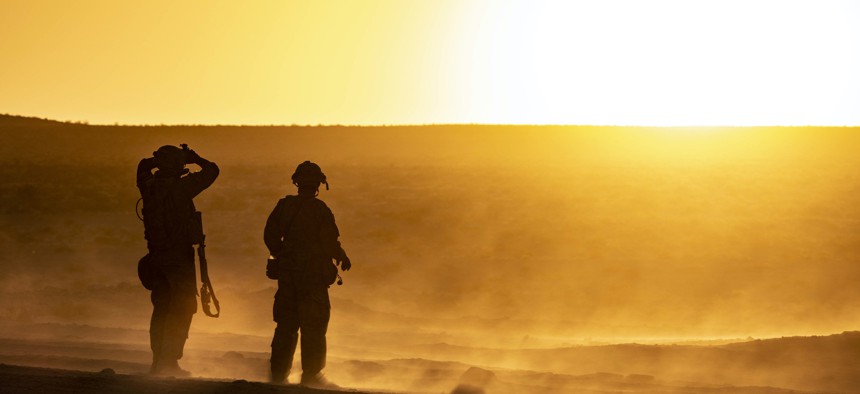
Two soldiers from 10th Special Forces Group Airborne look out over the desert of the National Training Center on Fort Irwin, California, Aug. 17, 2021. U.S. Army / Spc. Steven Alger
The Pentagon’s New Climate Plan Aims to Manage the Unavoidable
The new plan has considerably more specificity, requirements, objectives, and metrics than we had in 2014.
The Pentagon’s new Climate Adaptation Plan, released Oct. 7, is in many ways a follow-on strategy to the 2014 Climate Change Adaptation Roadmap. Having led the development of the earlier strategy as Acting Deputy Under Secretary of Defense for Installations and Environment, I feel comfortable saying that the 2021 version is much better.
The climate crisis is often described as two complementary challenges: managing the unavoidable and avoiding the unmanageable. The unavoidable includes the worsening conditions of the next 20 to 30 years, already baked in even if every nation on the globe drastically cuts emissions. The unmanageable are the greater catastrophes in the second half of the 21st century if we fail to do so.
The Pentagon must address both of these challenges, and is developing multiple lines of effort to do so. The U.S. military will need to understand and anticipate how climate stress will affect global stability, in areas of the world where it operates today and where it may need to operate tomorrow. Its thoughts on that challenge will soon be published in a Climate Risk Assessment. In addition, it will be charged with reducing emissions, increasing energy efficiency and renewable energy, and integrating electric vehicles. In response, it will be publishing a Sustainability Report and Implementation Plan later this year, after the anticipated Sustainability Executive Order is released.
The Climate Adaptation Plan, however, is about how the DoD can continue to conduct its missions despite climate change. It is about managing the unavoidable climate challenges of the coming decades.
In 2014, our adaptation strategy had a different emphasis. First and foremost, we were focused on making sure the Department understood the risks it faced. We embarked on a preliminary vulnerability assessment (the results of which were published in 2018). In addition, we understood that we couldn’t manage climate adaptation from a single office in the Pentagon and our strategy was founded on incorporating climate as a consideration in organization-wide guidance documents and official policy. This effort culminated in a DoD Directive on Climate Adaptation and Resilience. The Services developed guidance for installations such as the Navy’s Installation Adaptation and Resilience Planning Handbook in 2017 and the Army’s Climate Resilience Handbook in 2020.
The 2021 Climate Adaptation Plan starts from that foundation and builds a more comprehensive approach. It goes well beyond a focus on infrastructure—though the cost that climate change imposes on DoD infrastructure is still very pertinent. The plan asserts that the Department will incorporate climate considerations into intelligence assessments, into Combatant Commander theater engagement plans, and acquisition. The design of future systems will include the need to operate in greater extremes or new environments, such as the unbearable heat across the Middle East or the increasingly accessible Arctic. It explicitly acknowledges that the Department’s contractors will be affected by climate change as well, so it plans to work with its suppliers to increase their resilience. A key enabler in this plan which will help ensure its long-term success is an effort to increase the climate literacy of the DoD workforce, ranging from training for installation commanders to incorporation of climate security into professional military education.
The DoD’s 2021 plan has considerably more specificity, more requirements and objectives, and more metrics than we had in 2014. Critically, it mentions a climate dashboard being hosted on Advana, the Department’s enterprise analytics platform. Progress will be tracked and reported. This plan manages to bypass the bureaucratic trap of “admiring the problem,” and designs an approach that will help the Department execute its missions in this new environment.
In addition to being a more mature strategy, the Climate Adaptation Plan has another advantage that we did not. While both documents were published under supportive administrations, President Biden has elevated climate change in national security policy in a new way, which empowers this plan in a way the Roadmap was not. In the Pentagon, the Secretary of Defense regularly refers to climate change as a priority and as he says in the Plan’s Foreword, “we wouldn’t be doing our job if we weren’t thinking about how climate change will affect what we do,” sending the message that climate change is part of everyone’s mission.
Don't miss:
When we published the Climate Change Adaptation Roadmap in 2014, there was still no consensus in Congress on climate change and its impact on security. At the time, my staff was summoned to meet with congressional staffers looking to cut climate efforts out of the budget. Today, when climate change is discussed in defense hearings, there is bipartisan consensus that we need to protect the armed services from climate impacts. This is in part because we have years of increasing climate impacts and accelerating numbers of billion-dollar climate events that hadn’t occurred when we developed the original report, particularly when they impact DoD like they did when hurricanes struck Tyndall AFB and Camp Lejeune. In response to these impacts, Congresses of both Republican and Democratic majorities have passed important legislation to improve military resilience.
Fundamentally, the success of the new plan will be judged on the question I’ve heard from officials at all levels, from military installations to the Combatant Command staffs: “I understand climate change is important and that it’s a priority, but what am I supposed to do about it?” This plan gives them plenty to do as the Department prepares to defend the nation in an era that will be shaped by the changing climate.
John Conger is a Senior Advisor to the Council on Strategic Risks (CSR) and Director Emeritus of CSR’s Center for Climate and Security. He is the former U.S. Principal Deputy Under Secretary of Defense (Comptroller) and former Acting Assistant Secretary of Defense (Energy, Installations and Environment).




